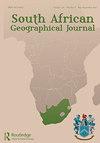Analysing factors influencing fire frequency in Hwange National Park
IF 1.4
4区 社会学
Q3 GEOGRAPHY
引用次数: 1
Abstract
ABSTRACT Detection of key factors driving fire frequency, especially in protected areas, is important for effective management of ecosystems. In this study, we used Generalized Linear Models to test the contribution of natural (NDVI, wind speed, dry matter productivity, soil moisture, percentage tree cover, elevation and temperature) and anthropogenic (distance from settlements) factors as predictors of fire frequency in Hwange National Park and adjacent areas. We used the Akaike Information Criterion (AIC) to evaluate the variable contribution to fire frequency. The model results indicated that all the variables that were used contributed significantly to fire recurrence (p < 0.05). Distance from settlements contributed the most to the model whilst dry matter productivity and annual average temperature were second and third respectively. Removal of distance from settlements from the model increased the AIC value to 1411.2 while removal of dry matter productivity and temperature resulted in AICs of 1269.9 and 1265.8 respectively. Results showed that settlements which are found in the vicinity of the protected area influence the recurrence of fires. Findings from this study can be used for strategic fire management and for the development of effective measures to minimize fire recurrence in a protected area.万基国家公园火灾发生频率影响因素分析
探测驱动火灾频率的关键因素,特别是在保护区,对于有效管理生态系统至关重要。在这项研究中,我们使用广义线性模型来测试自然因子(NDVI、风速、干物质生产力、土壤湿度、树木覆盖率百分比、海拔和温度)和人为因子(与住区的距离)对万基国家公园及其邻近地区火灾频率的预测作用。我们使用赤池信息准则(Akaike Information Criterion, AIC)来评估变量对火灾频率的贡献。模型结果表明,各变量对火灾复发均有显著影响(p < 0.05)。与居民点的距离对模型的影响最大,干物质生产力和年平均温度分别为第二和第三。从模型中去除与聚落的距离使AIC值增加到1411.2,而去除干物质生产力和温度使AIC值分别增加到1269.9和1265.8。结果表明,在保护区附近发现的定居点对火灾的再次发生有影响。这项研究的结果可用于战略火灾管理和制定有效措施,以尽量减少保护区的火灾复发。
本文章由计算机程序翻译,如有差异,请以英文原文为准。
求助全文
约1分钟内获得全文
求助全文
来源期刊

South African Geographical Journal
GEOGRAPHY-
CiteScore
3.40
自引率
7.10%
发文量
25
期刊介绍:
The South African Geographical Journal was founded in 1917 and is the flagship journal of the Society of South African Geographers. The journal aims at using southern Africa as a region from, and through, which to communicate geographic knowledge and to engage with issues and themes relevant to the discipline. The journal is a forum for papers of a high academic quality and welcomes papers dealing with philosophical and methodological issues and topics of an international scope that are significant for the region and the African continent, including: Climate change Environmental studies Development Governance and policy Physical and urban Geography Human Geography Sustainability Tourism GIS and remote sensing
 求助内容:
求助内容: 应助结果提醒方式:
应助结果提醒方式:


